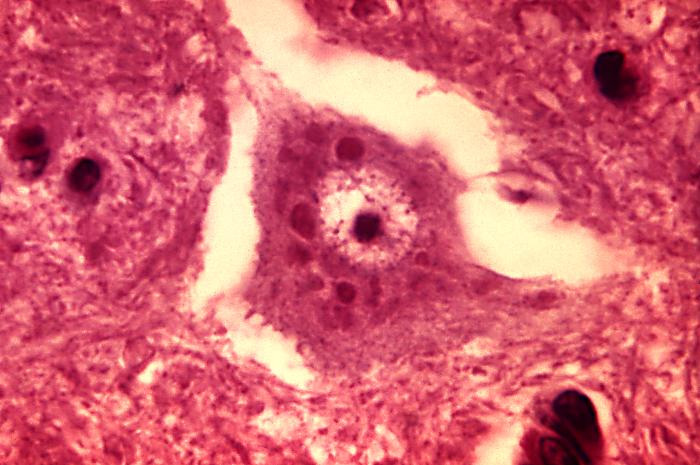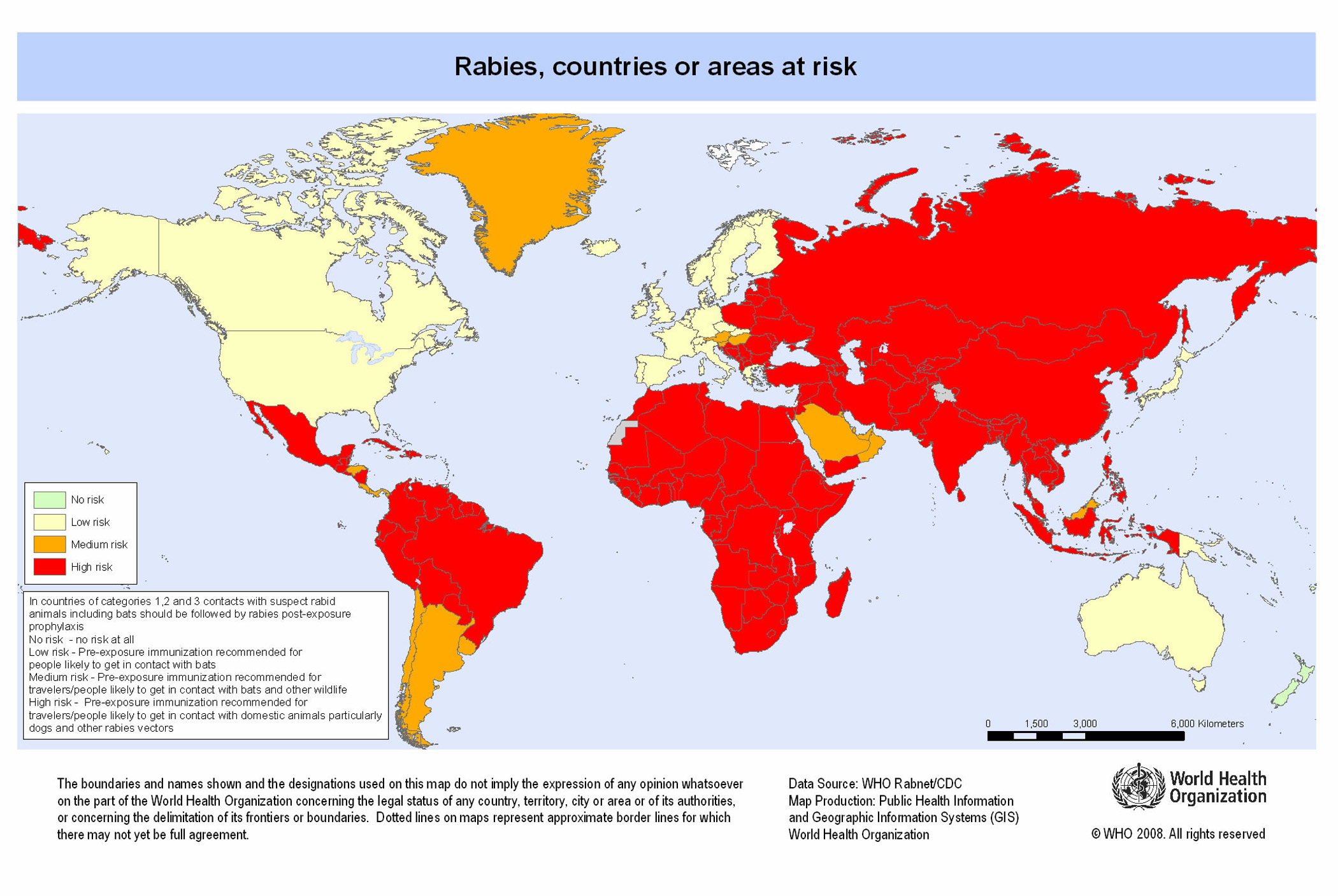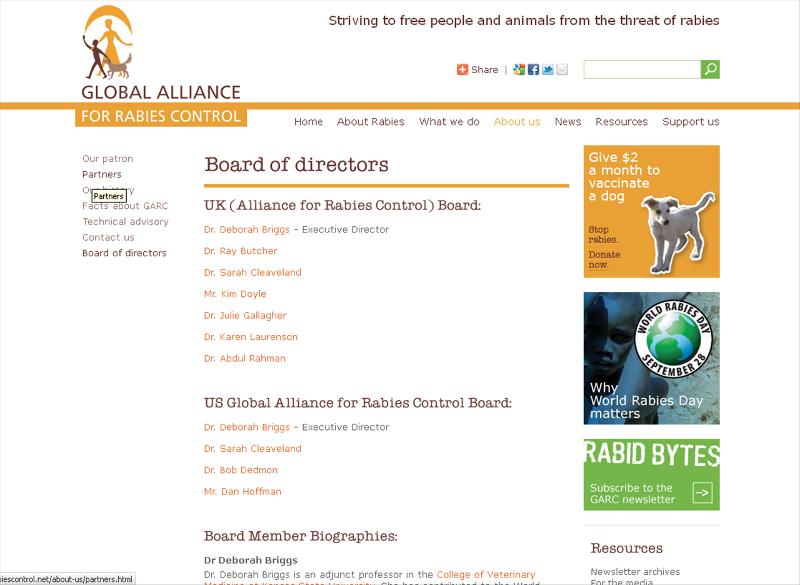
A Sidebar on Rabies Prevention
(Creating a Global Health Course and Game)
The breadth of global public health is all-encompassing, involving people, animals, and the environment. The spread of diseases may be mitigated through effective sanitation systems, research, disease surveillance, and medical interventions. Individuals and groups may practice healthy hygiene habits, proper nutrition, exercise, and lifestyle choices that promote health.
The complexity of global public health often means that global health practitioners choose areas of specialty. For Dr. Deborah J. Briggs, after a long and diverse career, she has focused on rabies prevention. This section highlights some basic facts about rabies. It also highlights her organization: the Global Alliance for Rabies Control (GARC).

[Note: The above is a micrograph showing the histopathologic changes associated with rabies encephalitis prepared using an H&E stain. This image was downloaded from the Centers for Disease Control and Prevention's (CDC) Public Health Image Library (PHIL), and is Image #3377. Rabies travels in the body along the central nervous system.]
By Dr. Deborah J. Briggs
Rabies is a virus that is transmitted in the saliva of an infected mammal and causes a fatal encephalitis. After it enters the body, usually through a bite wound, it travels along the peripheral nerves to the spinal cord and brain.It is considered a zoonotic disease because it is transmitted from animals to humans. Most human rabies deaths occur in Africa and Asia and are caused by the bite of an unvaccinated infected dog. All mammals can be infected with rabies but specific reservoir species in the US include: raccoons, skunks, foxes, and bats.
What is Rabies?
(Click on the link above to see a video that further elaborates on the issue.)
The clinical signs of rabies in animals are not always clear-cut. A behavior change may occur wherein a normally aggressive animal may suddenly be friendly and vice versa. There are two forms of rabies, 'furious' and 'paralytic' rabies. The names of the two types are self-explanatory. Because rabies virus affects the larynx or 'voice box', an infected animal may have a change in its voice.
What Animals are Most Likely to be Rabid?
Rabies symptoms develop between 1 to 6 weeks after exposure in what is called the "incubation period". Early symptoms of rabies are similar to those of the flu. Progressive rabies symptoms include insomnia, confusion, anxiety, hypersalivation, and slight or partial paralysis. There is also hydrophobia, or "fear of water" because of the pain of swallowing. In humans, symptoms of rabies may include loss of appetite, tiredness, headache, fever, and feeling unwell. Rabies is a progressive disease and an infected animal or human will only get worse.
Rabies Symptoms
Rabies has threatened humans since antiquity. It has the highest case fatality rate of any known infectious disease. Once clinical signs of the disease are evident, it is virtually 100% fatal. Most human rabies deaths occur in Africa and Asia where there are millions of unvaccinated free-roaming dogs. Bites from rabid dogs cause 99% of all global human rabies deaths.
Rabies Diagnosis
We actually have all of the tools we need to eliminate rabies in the dog populations of the world, and to prevent rabies in humans. These tools include excellent animal and human vaccines. Through modern communication methods, we can distribute educational messages to literally millions of people and thus increase their awareness about what to do if they are bitten or otherwise exposed to rabies.
Preventing Rabies
Any person who has been bitten or scratched by a potentially rabid animal should contact their physician right away. If the animal is rabid or cannot be tested, the dog bite victim should receive post-exposure prophylaxis, consisting of thorough wound washing, the administration of human rabies immune globulin, and a series of vaccine injections. Generally, it is not advisable to withhold treatment while waiting for diagnostic tests. People who are going into rabies endemic areas or who work with potentially rabid animals on a regular basis should receive immunizations as pre-exposure rabies prophylaxis.
A "cure" for rabies after the onset of clinical symptoms is not currently available. Our problem is that generally by the time a patient is diagnosed with rabies, the virus is already widely disseminated throughout the brain, and many researchers believe that the inability for drugs to cross the "blood-brain barrier" is a major deterrent to finding a cure for the disease. Additionally, the entire pathogenesis of rabies remains elusive although scientists continue to work on this problem.To find more information about treating human rabies victims, visit the "Milwaukee Protocol" website.
Rabies Medical Research
Pet owners should vaccinate their pets and keep their vaccination current. Owners should not allow their animals to roam free, and they should teach their children how to act around their pets. Adults and children should not approach any unknown animal, including wildlife. If bitten, even slightly, both adults and children should wash out the wound and get immediate medical attention.

(This World Health Organization map, "Rabies, countries or areas at risk," offers a global perspective of the rabies challenge.
This map was created in 2008. Updated Essential rabies maps by the WHO may be found here.)
The following video shows a visit that Dr. Deborah Briggs made to a village in India that has been working to prevent rabies.


The Global Alliance for Rabies Control is a not-for-profit organization that is focused on alleviating the burden of rabies in animals and humans.
GARC was established in 2007 and has united global stakeholders to take action against rabies. World Rabies Day (WRD), observed on September 28th, was the first global initiative of GARC and has been incredibly successful. To date, over 135 countries have participated in creative and original WRD events, and over 150 million people have received educational messages about how to prevent rabies.
Additionally, GARC sits as the Chair of the global informal group of rabies stakeholders called "Partners for Rabies Prevention" (PRP). Through the PRP, the first blueprint for elimination of rabies in dogs and prevention of rabies in humans was launched ( www.rabiesblueprint.com ). To see all the World Rabies Day movies at one link, please go to the following link.
Some of the following sites relate to the endeavors described above.
World Rabies Day
(A Side Note: The above sites were embedded using an Iframe placeholder. The sites are fully navigable within the window. As the sites are updated, they are updated within the Iframe as well.)
The following photo albums highlight various endeavors to combat rabies at various locales around the world. These are real-world images captured by both Dr. Deborah J. Briggs and others who work with her in the fight against rabies. These are offered to show a diversity of locations and methods in addressing rabies. Readers will notice that there are a range of rabies clinics, educational endeavors, the distribution of rabies vaccines, and other efforts. The photo albums are organized according to general time zones.
These photo albums are not part of the global health course. These are offered here to give readers a sense of the diversity of global public health work. The captions are provided by Dr. Deborah J. Briggs.
When viewing these digital photo albums, please consider some of the following questions.
The Global Rabies Prevention Work
In the United States...
The Importance of Public Education
The Nature of the Disease
Taking Part...Constructively
The images were submitted to the Global Alliance for Rabies Control, which sponsors the World Rabies Day event.
Note: Some of the images here are quite graphic.
-1.png)
(The above is an open-source map of time zones around the world, made available through Wikipedia and an open-source release.)
Note: Feel free to sample the photo albums for the regions that interest you. These do not all have to be viewed. There are regionalisms apparent in each of the different digital photo albums though. You may navigate to the next page at the top or at the bottom of this page. These slideshows are roughly organized according to their geographical time zones.
A dog is being offered oral rabies vaccine in a bait that has been put in a coconut shell with milk added. (Sri Lanka)

Animal care workers in Sri Lanka have developed a vaccinating device to administer rabies vaccine to free roaming dogs that allows the dog to be vaccinated without physically handling it.. (Sri Lanka)

This photo album consists of images taken by Dr. Deborah J. Briggs, in Delhi, Hyderabad, Jaipur, Shimla, and other locations in India. The images range from 1980 - the present.